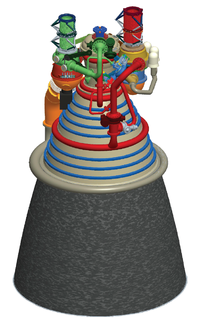- Nozzle extension
-
Nozzle extension — nozzle expander of reaction/rocket engine. The application of nozzle extensions improves efficiency of rocket engines in vacuum by increasing nozzle ratio. As a rule, their modern design assumes use of carbon-carbon materials without regenerative cooling. Along with sliding expanders, stationary nozzle extensions have some applications too.
Contents
Description
At present 2009 year, the search for various schemes to achieve higher area ratios for rocket nozzles stays an active field of research and patenting.[1][2] Generally, modern application of these designs can be divided on use for engines, which start their work at sea level and finish it at vacuum conditions, and on use for engines, which perform all their operations in vacuum.
"Air-to-vacuum" engines
For first stage rocket engines, the engine works with nozzle extension in disposed position during the first minutes of flight and expands it at some predefined level of air pressure. This scheme assumes the outer skirt of the bell is extended while the engine is functioning and its installation to working position happens in the upper layers of the atmosphere. It excludes problems with flow separation at sea level and increases efficiency of the engine in vacuum.[3] For example, application of nozzle extension for liquid rocket engine NK-33 improves the value of specific impulse up to 15-20 sec for near-space conditions. Therefore, this scheme adjusts the system to ambient conditions along the trajectory or, in other words, allows altitude compensation.
"Vacuum" engines
Rocket engines of upper stages perform all their operations in space and therefore in a vacuum. In order to achieve maximum efficiency for this class of engines they need high area ratios. This makes the nozzles a very sizable part of engine, which must be completely enclosed below the nose cone of rocket. The payload fairing and supporting constructions must endure all stresses and loads during launch and flight. Consequently, the use of outer expandable skirt in this case allows the size of upper stage and payload fairing to be minimized, which in turn decreases the total mass of the nose cone.[4] For these reasons, nozzle extensions are used for rocket engines RL-10 and RD-58.[4][5]
See also
References
- ^ (Russian) Extractable nozzle for rocket engine - Russian Patent 2180405, Russian patents
- ^ (Russian) Extractable nozzle for rocket engine - Russian Patent 2190111, Russian patents
- ^ (Russian) Work on modifying NK-33, News of cosmonautics, November 2002
- ^ a b RL10B-2 - NOZZLE EXTENSION ASSEMBLY IMPROVEMENTS FOR DELTA IV
- ^ (Russian) Expandable and fixed nozzle extensions without regenerative cooling, Discussion thread at "News of cosmonautics" forum
External links
- (Russian) Surprises of "Engines-2000", News of cosmonautics, April 2000
- (Russian) Patent of NPO Iskra, Patent department
- (Russian) The research of possible options for construction of liquid rocket engine with changeable nozzle ratio, Magazine "Engine"
- (Russian) Casing for fire, Magazine "Engine"
- Vulcain-2 Cryogenic Engine Passes First Test with New Nozzle Extension, European Space Agency
Categories:- Nozzles
- Rocket propulsion
- Spacecraft propulsion
Wikimedia Foundation. 2010.


